|
|
|
Sort Order |
|
|
|
Items / Page
|
|
|
|
|
|
|
| Srl | Item |
| 1 |
ID:
095117
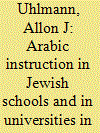

|
|
|
|
|
| Publication |
2010.
|
| Summary/Abstract |
Teaching is never merely a technical, pedagogical issue. This is especially true of Arabic teaching in Israel. Two related factors have conditioned the evolution of Arabic instruction in Israel in various, often contradictory ways. One is the Zionist modernist project of inventing a Jewish nation by bracketing off Jews from gentiles and reconstituting them as a distinct Hebraic ethno-linguistic community. The other is the project of securing historic Palestine as an exclusive national homeland for this newly invented nation and the consequent ambivalence toward Arab existence in historic Palestine. Both make up what I term Zionist sectarianism, and their influence on Arabic pedagogy has been decisive and pervasive, yet contradictory and unpredictable, demonstrating that although practice is always political, it is never mechanically reducible to its political underpinnings.
|
|
|
|
|
|
|
|
|
|
|
|
|
|
|
|
| 2 |
ID:
095119
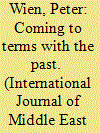

|
|
|
| 3 |
ID:
095113
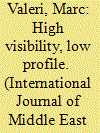

|
|
|
|
|
| Publication |
2010.
|
| Summary/Abstract |
If the U.S. invasion of Iraq in 2003 has produced unprecedented consequences for the internal policies of Middle Eastern regimes, this is not related to the upsurge of democratization that was supposed to spread like a contagion through the neighboring countries. Rather, it is due to the increased impact of the Shi?i issue on the national political agendas of many Arab states. Following the collapse of Saddam Hussein's regime, many observers thus drew attention to the emergence of what they regarded as a Shi?i "revival" in the Middle East-a perception that the military success of the Lebanese Hizbullah against Israel in the summer of 2006 seemed to confirm.
|
|
|
|
|
|
|
|
|
|
|
|
|
|
|
|
| 4 |
ID:
095107
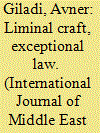

|
|
|
|
|
| Publication |
2010.
|
| Summary/Abstract |
In his monumental "Introduction to History," al-Muqaddima, Ibn Khaldun, the well-known Muslim historiographer and philosopher of history (d. 1406 a.d.), dedicates a whole chapter to midwifery (?in??at al-tawl?d) that is as original in conception as it is rich in detail. The chapter is included in Part V, which offers a survey of professions and crafts-"the 'accidents' of sedentary culture"-that for Ibn Khaldun reflect the sophistication of urban life. Within this survey, midwifery ranks among the most basic crafts (ummah?t al-?an??i?), being "something necessary in civilization and a matter of general concern, because it assures, as a rule, the life of the newborn child." Moreover, like "the art of writing, book production, singing, and medicine," midwifery is regarded as a noble craft because of the subject that is at the heart of it (shar?f bi-l-maw???).
|
|
|
|
|
|
|
|
|
|
|
|
|
|
|
|
| 5 |
ID:
095115
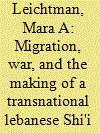

|
|
|
|
|
| Publication |
2010.
|
| Summary/Abstract |
The July 2006 Lebanon war was an important turning point for West African Lebanese. For the first time since their formation as a community, the Lebanese in Senegal organized a demonstration in Dakar displaying solidarity with Lebanon. This protest illuminates the dynamics between global forces and local responses. Hizbullah's effectiveness in winning the international public opinion of both Sunni and Shi?i Muslims in the war against Israel led to a surge in Lebanese diaspora identification, even among communities who had not been similarly affected by previous Lebanese wars. By analyzing the role of a Lebanese shaykh in bringing religious rituals and a Lebanese national identity to the community in Senegal, this article explores how members of the community maintain political ties to Lebanon even when they have never visited the "homeland" and sheds new light on the relationship among religion, migration, and (trans)nationalism.
|
|
|
|
|
|
|
|
|
|
|
|
|
|
|
|
| 6 |
ID:
095109
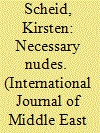

|
|
|
|
|
| Publication |
2010.
|
| Summary/Abstract |
In his studio in Beirut in 1929, the young artist Moustapha Farroukh (1901-57) envisioned a composition to change his society. He hoped his oil painting would incite broad support among his fellow Lebanese for a revolution in conventional gender relations and women's participation in the urban social order. He titled the picture The Two Prisoners and based it on a European convention for representing the East: the Nude odalisque (Figure 1). The resulting painting exemplifies the complex role Arab intellectuals of the early 20th century played in the formation of modern art and universal modernity. Leading artists in Mandate-era Beirut felt compelled to paint Nudes and display them as part of a culturing process they called tathq?f (disciplining or enculturing). To a large extent, tathq?f consisted of recategorizing norms for interaction and self-scrutiny. Joseph Massad has revealed that one crucial component of tathq?f was the repudiation of behaviors and desires associated with the Arab Past, such as male homosexuality. An equally important component was the cultivation of "modern," "masculine" heterosexual eroticism and a dutiful feminine compliance associated with ?ad?tha (novelty) and mu???ira (contemporaneity). This was accomplished through the use of a genre that was deliberately new and alien in both its material media and its impact on makers and viewers.
|
|
|
|
|
|
|
|
|
|
|
|
|
|
|
|
| 7 |
ID:
095111
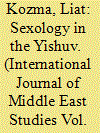

|
|
|
|
|
| Publication |
2010.
|
| Summary/Abstract |
In late 1931, German sexologist and gay-rights activist Magnus Hirschfeld, quoted above, visited Palestine for a lecture tour that attracted hundreds in Tel Aviv, Jerusalem, Haifa, and kibbutz Beit Alfa. By this time, the Jewish settlers' community (or Yishuv) in Mandate Palestine had already been exposed to the science of sexology and to the reform movement it inspired. Sexual-hygiene manuals had been translated into Hebrew and Yiddish in both Tel Aviv and Warsaw. Hebrew readers had access, for example, to translations of Auguste Forel's Sexual Ethics and Max Hodann's A Boy and a Girl. Finally, in the fall and winter of 1931-32, three sex consultation centers were opened in Tel Aviv.
|
|
|
|
|
|
|
|
|
|
|
|
|
|
|
|
|
|
|
|
|